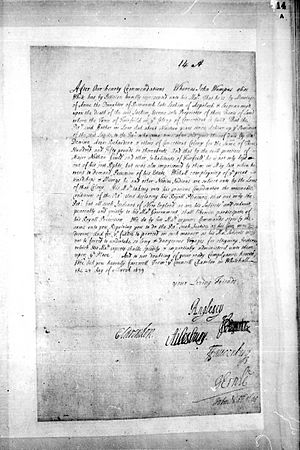Wampage facts for kids
Quick facts for kids
Wampage I
|
|
|---|---|
| Anhōōke | |
| Siwanoy leader | |
| Succeeded by | Wampage II |
| Personal details | |
| Died | Abt. 1680 |
| Spouses | Prasque (Anne), daughter of Romaneck |
| Children |
|
| Known for | Massacre of Anne Hutchinson |
| Mother tongue | Munsee |
Wampage I (/ˈwɒmpɒɡiː/), also known as Anhōōke, was an important leader (called a Sagamore or chieftain) of the Siwanoy Native American people. The Siwanoy lived in the area we now call the Bronx and Westchester County, New York. Wampage I was involved in a historical event in 1643 concerning Anne Hutchinson and her group of settlers.
Around 1636, Wampage I married Prasque. Her father, Romaneck, was the main chief of the Wappinger group of tribes. The Siwanoys were part of the Wappinger people. During Wampage's time as chief, the Siwanoys were involved in Kieft's War. They also had many disagreements with the Dutch colony of New Netherland. Wampage I's name was spelled in different ways, like Wamponneage, Wampus, and Wampers.
Contents
The 1643 Event with Anne Hutchinson
In August 1643, the Siwanoy people, led by Wampage I, were involved in an attack on the family of Anne Hutchinson. Some historical writings suggest that Wampage himself was involved in the death of Hutchinson. It is also said that he took the name Anhōōke because of a custom among the Mohican people. This custom involved taking the name of a notable person one had personally defeated.
The land where this event was thought to have happened became known as "Anne's Hoeck" or Ann Hook's Neck. Today, this area is called Rodman's Neck. Many sources also say that Anne's daughter, Susanna Hutchinson, was the only survivor of the attack. It is believed she had a son with Wampage while she was with the Siwanoy. This son, Ninham-Wampage, later became Wampage II after his father's death.
Agreements with Thomas Pell
After the 1643 event, Wampage became friends with Thomas Pell. Pell was an Indian Commissioner in Fairfield, Connecticut. On June 27, 1654, the Siwanoys sold a large area of land to Pell. This land was about 9,160 acres. It included parts of the Bronx and areas east of the Hutchinson River, stretching north to Mamaroneck.
Wampage and other Siwanoy leaders signed a treaty under a special tree called the Treaty Oak. This tree was near the Bartow Pell Mansion in Pelham. Wampage signed as Anhōōke, along with other Sagamores like Shāwānórōckquot and Poquōrūm. Other Siwanoy people also signed as witnesses. This agreement stated that the Siwanoys and the English would try to solve any future land disagreements peacefully.
On March 10, 1658, Wampage I and Pell worked out another important agreement. This treaty clearly set out the land claims for both the English and the Siwanoys. This agreement later helped keep Wampage and the Siwanoys out of King Philip's War.
Later Life and Important Ruling
Around 1677, Wampage, who was getting older, went to Fairfield. He wanted to collect money for land he had sold to people living there. This land he had inherited from his father-in-law, Romaneck. However, Nathan Gold, a main judge in Fairfield, had Wampage beaten and put in jail. Gold claimed that the English owned all lands because they had won them in battle. He also said that agreements between the English and Native Americans were not valid.
Sir John Pell, who was the second Lord of Pelham Manor, helped Wampage. He spoke for Wampage before the Privy Council of the United Kingdom. The Privy Council was a very important group of advisors to the British King. On March 28, 1679, the Council decided in Wampage's favor. They said that Gold's actions were wrong. They also stated that Wampage, and all Native Americans in New England who peacefully followed the British government, should have the King's protection.
By the time of this ruling, Wampage and Prasque had been baptized. They took the names John and Anne White. The Privy Council's ruling called him "John Wampus alias White." It referred to his wife as "Anne the Daughter of Romanock." Wampage died soon after this, before July 1681. While his burial place is not fully known, some believe he was buried in a mound on the northern coast of Rodman's Neck.
Family and Descendants
Wampage I was known to have two children:
- Wampage II, also called Ninham-Wampage. It is traditionally said that his mother was Susanna Hutchinson. After Wampage I died, Ninham-Wampage became Wampage II and took on his father's leadership role. He also used a name similar to Anhōōke. In 1692, he used the name "Wampage, alias Ann-hook" when he sold more land. This has sometimes caused confusion between the father and son in historical records. Sources say that Wampage II's daughter, Anna, married Thomas Pell II, who was the third Lord of Pelham Manor. Anna grew up on Hunter Island.
- John Wampage White, his son with Prasque (Anne). John married Elizabeth French. Their children were Elizabeth (who married John Tompkins), Mary, and Nathaniel White.


